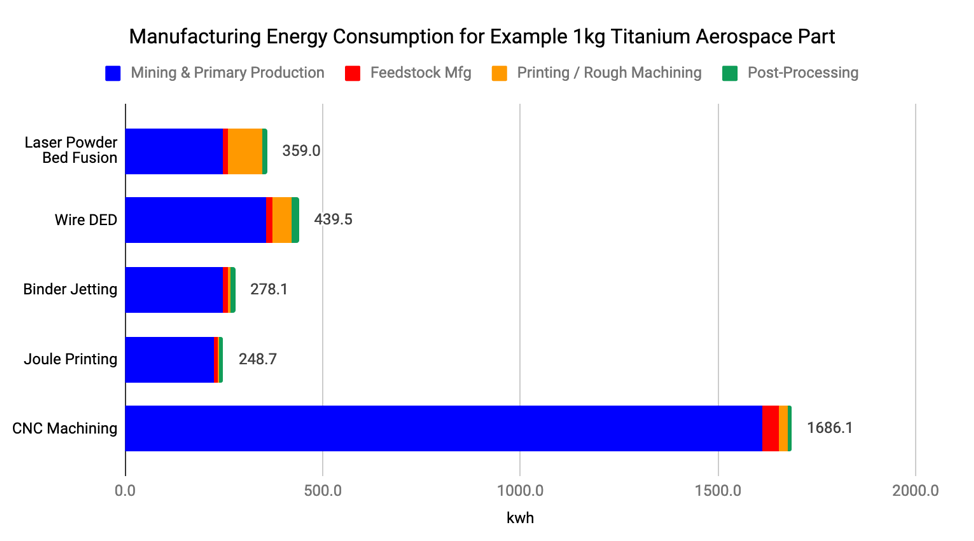![Total energy consumed (kWh) by the different process to manufacture an example part [Image: Digital Alloys]](https://fabbaloo.com/wp-content/uploads/2020/05/7_img_5eb099b7804b4.png)
Metal 3D printing is on the rise, but a lot of questions still remain.
Metal technologies are drawing great attention as the unique geometries and component reduction capabilities of additive manufacturing offer great promise for bespoke, intricate, high-end, medical, and other parts. It’s not all good news, of course; there’s a long way to go yet for mainstream adoption, for pricing to be more competitive, for more materials capabilities.
Post-processing has long been heralded as the “dirty little secret” of additive manufacturing and, to an extent, it still is. More informed users and stronger end-to-end training and support are diluting the secrecy there. But one area that’s still not especially talked about is energy usage.
Any industrial process requires energy to run: that’s a simple fact of manufacturing. But how much is “too much” energy, and where do power bills come into the financial figuring when investing in a new system?
Digital Alloys has been examining metal additive manufacturing processes in a series lately, and energy consumption is their latest topic.
They explain:
“Metals production, from mining ore through manufacturing parts, accounts for 7% of our global energy use. While metal additive manufacturing (AM) has been promoted as a way to help us reduce our carbon footprint, this has not been well demonstrated with clear and complete information. Furthermore, there lacks a comprehensive comparison of energy consumption by the different metal AM processes. To optimize when, where, which, and how to implement AM, we must be able to assess its environmental impact and compare this to conventional manufacturing processes like CNC Machining.”
What follows is a thorough discussion and comparison with traditional CNC machining for some of the major metal additive manufacturing processes. Of course because the piece is from a supplier, they do place focus on their own Joule Printing technology — but in a way that’s backed with science and shows where their process fits among other metal offerings.
Sometimes it can be easy to focus just on what happens in-house when it comes to considering energy consumption: How much energy are my operations using? What does our bill look like?
That’s not the whole story, though. There’s a whole supply chain before anything even gets into anyone’s operations. The metals have to be mined and processed — alloyed and turned into feedstock powders or wires — to begin the story.
![The metal manufacturing process [Image: Digital Alloys]](https://fabbaloo.com/wp-content/uploads/2020/05/1_img_5eb099b80f6c5.png)
If anyone else is watching The Good Place, think of the example in the most recent season of a fellow bringing an apple to his sick grandma. Centuries ago, he plucked an apple from his own orchard and gave it to granny: Good Place points! In the 21st century, he buys an apple at the market and gives it to granny, ultimately pulling points that point more to the Bad Place, because child labor was used to help grow the apple, then it had to be shipped with a major carbon footprint over to where he was. Trying to do a good thing actually showed that he was supporting unsustainable and inhumane practices.
So take that and apply it to what we’re doing with industry: it starts before a CAD design. The supply chain isn’t so streamlined as it was in perhaps the Bronze Age, but now has middlemen, shipping, and many more steps before that clean powder is ready for a state-of-the-art metal 3D printer.
Once there are specific materials for specific processes, though, the steps continue: the printing process, post-processing, material recycling.
![Same as above, but focusing on the metal AM processes, pulling CNC out from the chart [Image: Digital Alloys]](https://fabbaloo.com/wp-content/uploads/2020/05/8_img_5eb099b874865.png)
The entire piece is well thought-through and worth a read for a more in-depth discussion of energy consumption in additive manufacturing — and as food for thought regarding general metal manufacturing.
Additive manufacturing remains a nascent industry overall, and the more we think about sustainability and other pressing global issues in early days, the more sustainable practices can be put into place as a foundation. Thinking end to end is necessary not just in adoption, but in industry overall.
Via Digital Alloys











Aerosint and Aconity have proven out their work in multi-metal powder deposition 3D printing.